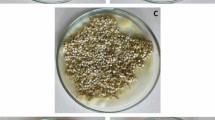Abstract
In the present study we report the chemical composition of the Cretan Phoenix theophrasti Gr. fruits, in comparison with dates, from its close relative Phoenix dactylifera L. for their nutritional value and their potential exploitation as a source of bioactive components such as phytosterols, lipids and polyphenols. The non polar dichloromethane (CH2Cl2) extract of the fruits was analysed by several techniques (TLC, CC, GC and GC-MS) and was found to consist mainly from fatty acids, hydrocarbons and phytosterols. Palmitic acid was the most abundant fatty acid, 12.49% of total saponifiables, while β-sitosterol was the most prevalent phytosterol, 29.46% of total unsaponifiable lipid fraction. The polar methanolic extract was examined for its total phenolic content, by the Folin–Ciocalteu assay, as well as for its antioxidant activity through DPPH assay, in comparison with previous studies on the fruits of several Phoenix dactylifera varieties. This fraction was found to possess strong antioxidant activity despite its lower content of phenolic compounds in comparison with previously studied Phoenix dactylifera specimens.




Similar content being viewed by others
Abbreviations
- CC:
-
column chromatography
- FAME:
-
fatty acid methyl esters
- GC:
-
gas chromatography
- GC-MS:
-
gas chromatography mass spectrometry
- NMR:
-
nuclear magnetic resonance spectroscopy
- NP:
-
non polar extract
- P:
-
polar extract
- SFA:
-
saturated fatty acids
- TLC:
-
thin layer chromatography
References
Greuter W (1968) Le dattier de Théophraste, spécialité crétoise. Mus Geneve 2(81):14–16
Kislev ME, Hartmann A, Galili E (2004) Archaeobotanical and archaeoentomological evidence from a well at Atlit-Yam indicates colder, more humid climate on the Israeli Coast during the PPNC period. J Archaeol Sci 31(9):1301–1310, doi:10.1016/j.jas.2004. 02.010
Al-Hooti S, Sidhu JS, Qabazard H (1998) Chemical composition of seeds of date fruit cultivars of United Arab Emirates. J Food Sci Technol 35:44–46
Fayadh JM, Al-Showiman SS (1990) Chemical composition of date palm (Phoenix dactylifera L.). J Chem Soc Pak 12:84–103
Ahmed AI, Ahmed AWK, Robinson RK (1995) Chemical composition of date varieties as influenced by the stage of ripening. Food Chem 54:305–309, doi:10.1016/0308-8146(95)00051-J
Wang Y, Sunwoo H, Cherian G, Sim JS (2000) Fatty acid determination in chicken egg yolk: a comparison of different methods. Poult Sci 79:1168–1171
Zaki AK, Schmidt J, Hamouda FM, Adam G (1993) Steroidal constituents from pollen grains of Phoenix dactylifera. Planta Med 59(7):A613–A614, doi:10.1055/s-2006-959837
Zipser B, Bradford JJ, Hollingsworth RI (1998) Cholesterol and its derivatives are the principal steroids isolated from the leech species Hirudo medicinalis. Comp Biochem Physiol C 120(2):269–282
Fernández MI, Pedro JR, Seoane E (1983) Constituents of a hexane extract of Phoenix dactylifera. Phytochemistry 22(9):2087–2088, doi:10.1016/0031-9422(83)80054-5
Akihisa T, Schimizu N, Parthasarathu G, Thakur S, Rosenstein FU, Tamura T, Matsumoto T (1987) Sterols of the Cucurbitaceae. Phytochemistry 26(6):1693–1700, doi:10.1016/S0031-9422(00)82270-0
Gutfinger T (1981) Polyphenols in olive oils. J Am Oil Chem Soc 58:966–968, doi:10.1007/BF02659771
Mansouri A, Embarek G, Kokkalou E, Kefalas P (2005) Phenolic profile and antioxidant activity of the Algerian ripe date palm fruit (Phoenix dactylifera). Food Chem 89(3):411–420, doi:10.1016/j.foodchem.2004.02.051
Nenadis N, Tsimidou M (2002) Observations on the estimation of scavenging activity of phenolic compounds using rapid 1,1-diphenyl-2-picrylhydrazyl (DPPH) tests. J Am Oil Chem Soc 79(12):1191–1195
Besbes S, Blecker C, Deroanne C, Drira N-E, Attia H (2004) Date seeds: chemical composition and characteristic profiles of the lipid fraction. Food Chem 84:577–584, doi:10.1016/S0308-8146(03)00281-4
Al-Shahib W, Marshall RJ (2003) Fatty acid content of the seeds from 14 varieties of date palm Phoenix dactylifera L. Int J Food Sci Technol 38:709–712, doi:10.1046/j.1365-2621.2003.00723.x
Devshony S, Eteshola E, Shani A (1992) Characteristics and some potential applications of date palm (Phoenix dactylifera L.) seeds and seed oil. J Am Oil Chem Soc 69(6):595–597, doi:10.1007/BF02636115
Mossa JS, Hifnawy MS, Mekkawi AG (1986) Phytochemical and biological investigation on date seeds (Phoenix dactylifera L.) produced in Saudi Arabia. Arab Gulf J Sci Res 4:495
Bennett RD, Shui-tze K, Heftmann E (1966) Isolation of estrone and cholesterol from the date palm, Phoenix dactylifera L. Phytochemistry 5(2):231–235, doi:10.1016/S0031-9422(00)85122-5
de Jong N, Plat J, Mensink RP (2003) Metabolic effects of plant sterols and stanols. J Nutr Biochem 4:362–369, doi:10.1016/S0955-2863(03)00002-0
Moreau RA, Whitaker BD, Hicks KB (2002) Phytosterols, phytostanols, and their conjugates in foods: structural diversity, quantitative analysis, and health promoting uses. Prog Lipid Res 41:457–500, doi:10.1016/S0163-7827(02)00006-1
Mahran GH, Abdel-Wahab SM, Attia AM (1976) A phytochemical study of date palm pollen. Planta Med 29(2):172–175
Vayalil PK (2002) Antioxidant and antimutagenic properties of aqueous extract of date fruit (Phoenix dactylifera L. Arecaceae). J Agric Food Chem 50:610–617, doi:10.1021/jf010716t
Alencar SM, Oldoni TLC, Castro ML, Cabral LSR, Costa-Neto CM, Cury JA, Rosalen JA, Ikegaki M (2007) Chemical composition and biological activity of a new type of Brazilian propolis: red propolis. J Ethnopharmacol 113:278–283, doi:10.1016/j.jep.2007.06.005
Jiang H, Ji B, Liang J, Zhou F, Yang Z, Zhang G (2006) Changes of contents and antioxidant activities of polyphenols during fruit development of four apple cultivars. Eur Food Res Technol 223:743–748, doi:10.1007/s00217-006-0262-8
Vundac VB, Brantner AH, Placibat M (2007) Content of polyphenolic constituents and antioxidant activity of some Stachys taxa. Food Chem 104:1277–1281, doi:10.1016/j.foodchem.2007.01.036
Author information
Authors and Affiliations
Corresponding author
Rights and permissions
About this article
Cite this article
Liolios, C.C., Sotiroudis, G.T. & Chinou, I. Fatty Acids, Sterols, Phenols and Antioxidant Activity of Phoenix theophrasti Fruits Growing in Crete, Greece. Plant Foods Hum Nutr 64, 52–61 (2009). https://doi.org/10.1007/s11130-008-0100-1
Published:
Issue Date:
DOI: https://doi.org/10.1007/s11130-008-0100-1




